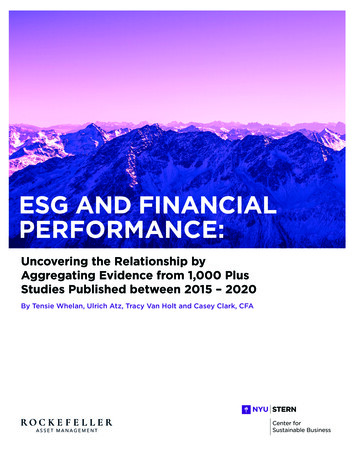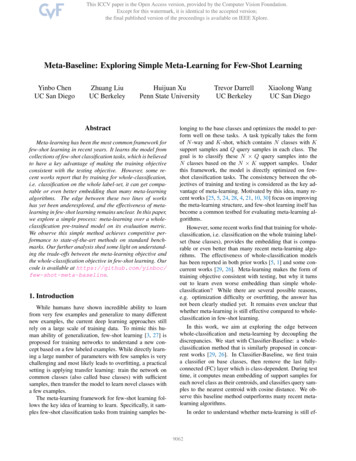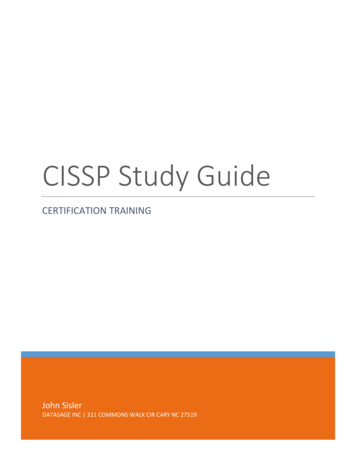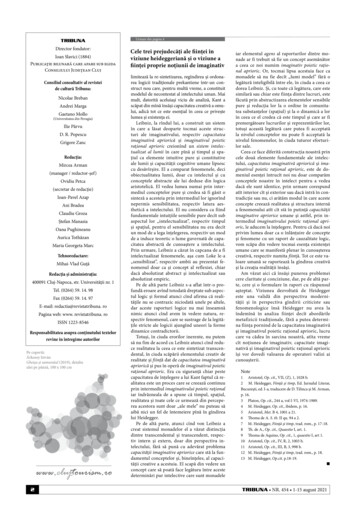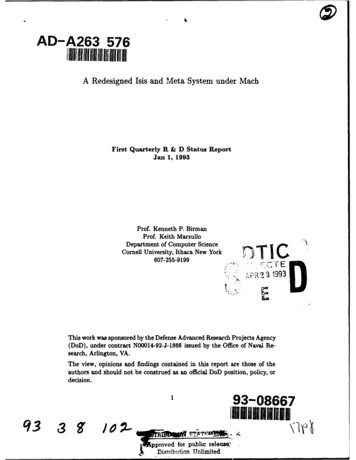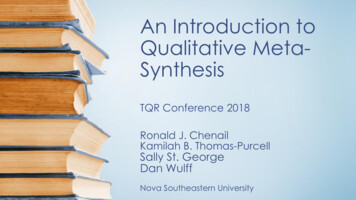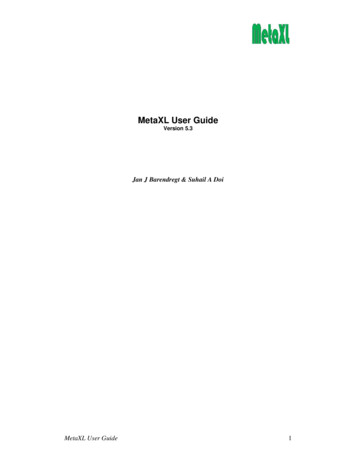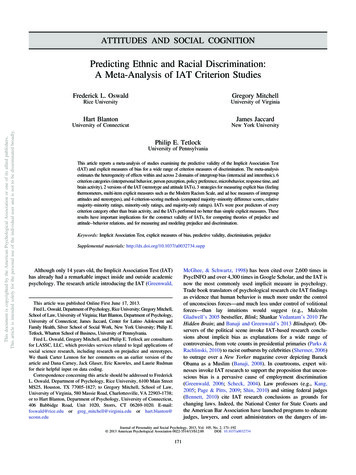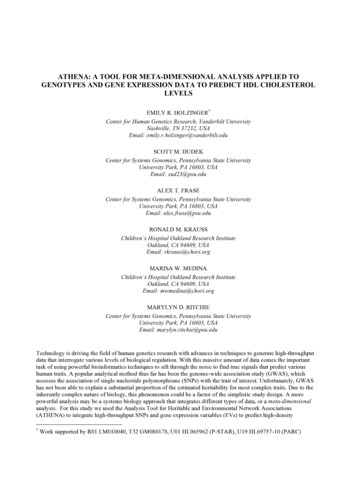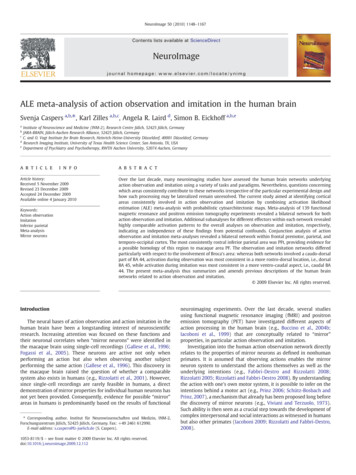
Transcription
NeuroImage 50 (2010) 1148–1167Contents lists available at ScienceDirectNeuroImagej o u r n a l h o m e p a g e : w w w. e l s e v i e r. c o m / l o c a t e / y n i m gALE meta-analysis of action observation and imitation in the human brainSvenja Caspers a,b,⁎, Karl Zilles a,b,c, Angela R. Laird d, Simon B. Eickhoff a,b,eaInstitute of Neuroscience and Medicine (INM-2), Research Centre Jülich, 52425 Jülich, GermanyJARA-BRAIN, Jülich-Aachen Research Alliance, 52425 Jülich, GermanycC. and O. Vogt Institute for Brain Research, Heinrich-Heine-University Düsseldorf, 40001 Düsseldorf, GermanydResearch Imaging Institute, University of Texas Health Science Center, San Antonio, TX, USAeDepartment of Psychiatry and Psychotherapy, RWTH Aachen University, 52074 Aachen, Germanyba r t i c l ei n f oArticle history:Received 5 November 2009Revised 23 December 2009Accepted 24 December 2009Available online 4 January 2010Keywords:Action observationImitationInferior parietalMeta-analysisMirror neuronsa b s t r a c tOver the last decade, many neuroimaging studies have assessed the human brain networks underlyingaction observation and imitation using a variety of tasks and paradigms. Nevertheless, questions concerningwhich areas consistently contribute to these networks irrespective of the particular experimental design andhow such processing may be lateralized remain unresolved. The current study aimed at identifying corticalareas consistently involved in action observation and imitation by combining activation likelihoodestimation (ALE) meta-analysis with probabilistic cytoarchitectonic maps. Meta-analysis of 139 functionalmagnetic resonance and positron emission tomography experiments revealed a bilateral network for bothaction observation and imitation. Additional subanalyses for different effectors within each network revealedhighly comparable activation patterns to the overall analyses on observation and imitation, respectively,indicating an independence of these findings from potential confounds. Conjunction analysis of actionobservation and imitation meta-analyses revealed a bilateral network within frontal premotor, parietal, andtemporo-occipital cortex. The most consistently rostral inferior parietal area was PFt, providing evidence fora possible homology of this region to macaque area PF. The observation and imitation networks differedparticularly with respect to the involvement of Broca's area: whereas both networks involved a caudo-dorsalpart of BA 44, activation during observation was most consistent in a more rostro-dorsal location, i.e., dorsalBA 45, while activation during imitation was most consistent in a more ventro-caudal aspect, i.e., caudal BA44. The present meta-analysis thus summarizes and amends previous descriptions of the human brainnetworks related to action observation and imitation. 2009 Elsevier Inc. All rights reserved.IntroductionThe neural bases of action observation and action imitation in thehuman brain have been a longstanding interest of neuroscientificresearch. Increasing attention was focused on these functions andtheir neuronal correlates when “mirror neurons” were identified inthe macaque brain using single-cell recordings (Gallese et al., 1996;Fogassi et al., 2005). These neurons are active not only whenperforming an action but also when observing another subjectperforming the same action (Gallese et al., 1996). This discovery inthe macaque brain raised the question of whether a comparablesystem also exists in humans (e.g., Rizzolatti et al., 2001). However,since single-cell recordings are rarely feasible in humans, a directdemonstration of mirror properties for individual human neurons hasnot yet been provided. Consequently, evidence for possible “mirror”areas in humans is predominantly based on the results of functional⁎ Corresponding author. Institut für Neurowissenschaften und Medizin, INM-2,Forschungszentrum Jülich, 52425 Jülich, Germany. Fax: 49 2461 612990.E-mail address: s.caspers@fz-juelich.de (S. Caspers).1053-8119/ – see front matter 2009 Elsevier Inc. All rights imaging experiments. Over the last decade, several studiesusing functional magnetic resonance imaging (fMRI) and positronemission tomography (PET) have investigated different aspects ofaction processing in the human brain (e.g., Buccino et al., 2004b;Iacoboni et al., 1999) that are conceptually related to “mirror”properties, in particular action observation and imitation.Investigation into the human action observation network directlyrelates to the properties of mirror neurons as defined in nonhumanprimates. It is assumed that observing actions enables the mirrorneuron system to understand the actions themselves as well as theunderlying intentions (e.g., Fabbri-Destro and Rizzolatti 2008;Rizzolatti 2005; Rizzolatti and Fabbri-Destro 2008). By understandingthe action with one's own motor system, it is possible to infer on theintentions behind a motor act (e.g., Prinz 2006; Schütz-Bosbach andPrinz, 2007), a mechanism that already has been proposed long beforethe discovery of mirror neurons (e.g., Viviani and Terzuolo, 1973).Such ability is then seen as a crucial step towards the development ofcomplex interpersonal and social interactions as witnessed in humansbut also other primates (Iacoboni 2009; Rizzolatti and Fabbri-Destro,2008).
S. Caspers et al. / NeuroImage 50 (2010) 1148–1167Understanding an action and its intention might also provide animportant link between the sole observation of an action and itssubsequent imitation by directly copying the observed action (e.g.,Fabbri-Destro and Rizzolatti, 2008; Rizzolatti and Craighero, 2004;Rumiati et al., 2005). Furthermore, imitation offers a potentialmechanism for learning from the early stages of life. The motorsystem can learn how specific actions are carried out by imitatingthem (e.g., Bandura and Wood, 1989; Brass and Heyes, 2005; Iacoboni,2005), a mechanism that has long been discovered much earlier inhuman neonates (Meltzoff and Moore, 1977). Furthermore, just likeaction understanding, imitation processes play an important roleduring social interactions: people also tend to imitate behaviours oftheir social partners (either consciously or subconsciously) to adapt toa given social situation (e.g., Bargh et al., 1996; Iacoboni, 2009;Niedenthal et al., 1985; Schilbach et al., 2008a).Therefore, assessment of the neural substrates of both actionobservation and action imitation is not only important for understanding action-related processes but also holds further implicationsfor cognitive and social neuroscience. In spite of the considerablenumber of neuroimaging studies on these action-related topics, theorganisation of the respective networks in the human brain and theiranatomical correlates are still disputed (Dinstein et al., 2008; Iacoboni,2005, 2009; Keysers and Gazzola, 2009). One controversial aspect isthe role of Broca's region in action- related processes (Brass andHeyes, 2005; Molenberghs et al., 2009; Molnar-Szakacs et al., 2005;Vogt et al., 2007). Another is the hemispheric dominance of suchfunctions, as arguments have been made for a leading role of eitherhemisphere as well as for a bilateral distribution (e.g., Iacoboni andDapretto, 2006). Finally, since observation and imitation are closelyrelated, the question of whether they are sustained by the sameneuronal networks or engage different brain areas is still disputed(e.g., Heyes, 2001; Brass and Heyes, 2005; Turella et al., 2009a,b).One reason for the diverging evidence on the involvement ofdifferent brain regions in these networks is the heterogeneity of theexperimental approaches, such as paradigms and effectors (e.g.,hand/fingers, face, feet), that have been used to delineate the neuralcorrelates of these functions. To identify those areas in the humanbrain that are consistently implicated in action processing, the resultsof these different studies should be synopsized in a quantitative,unbiased fashion. Previous summaries of published studies on actionobservation or imitation have consisted of qualitative reviews of thereported activation sites (e.g., Brass and Heyes, 2005; Fabbri-Destroand Rizzolatti, 2008; Iacoboni, 2005, 2009; Rizzolatti et al., 2001).However, a promising new approach for identifying the neuralsubstrates of action observation and imitation in humans is the useof coordinate-based meta-analysis. These analyses aim at revealingareas that are consistently activated in a particular class of paradigms(Laird et al., 2005a, 2009; Eickhoff et al., 2009).The aim of the present study was to provide a quantitative metaanalysis of the current neuroimaging literature to delineate consistently activated cortical regions associated with action observationand imitation. In a first step, the neural correlates of these processeswere analysed separately. Additional subanalyses that assessed theeffects of potential confounds, such as effectors or instructions, werecarried out to evaluate the consistency of the findings. Conjunction andcontrast analyses were performed to reveal divergent and convergentareas for action observation and imitation. Using probabilisticcytoarchitectonic maps of cortical areas, activations identified ineach analysis were specifically allotted to the most probable brain area.Material and methodsData used for the meta-analysisFunctional imaging studies included in the meta-analysis wereobtained from the BrainMap database (www.brainmap.org; Fox and1149Lancaster, 2002, Laird et al., 2005b) and a PubMed literature search(www.pubmed.org, search strings: “mirror neurons”, “imitation”, and“action observation”) on functional magnetic resonance imaging(fMRI) and positron emission tomography (PET) experiments. Theliterature cited in the obtained papers was also assessed to identifyadditional neuroimaging studies dealing with action observation orimitation processing. Only studies that reported results of wholebrain group analyses as coordinates in a standard reference space(Talairach/Tournoux, MNI) were analysed, while single-subjectreports were excluded. Based on these criteria, 87 articles (reporting83 fMRI and 4 PET studies) were designated as suitable for metaanalysis. Together, these studies included data from 1289 subjects andreported 139 experiments with 1932 activation foci (Table 1).The reported tasks were subsumed into two main categories:“action observation” and “action imitation”: 104 experimentsreported action observation tasks (1061 subjects, 1390 activationfoci), and 35 reported imitation tasks (459 subjects, 542 activationfoci). Action observation comprised those experiments in whichsubjects were instructed to observe the action performed by otherswithout performing their own motor act. In this first analysis, thegeneral action observation brain network was assessed. There are,however, several possible confounds that may influence the analysisacross the whole sample of observation and imitation experiments,like effectors, instructions or the involvement of an object. To explorethe effects of these potential confounds, we subdivided the studiesinto several subgroups. These were then analysed separately to revealthe neural correlates of different forms of action observation andcompared among each other by contrast and conjunction analyses:observation of hand actions (‘right hand’ (37 experiments), ‘left hand’(2 experiments), ‘both hands’, or ‘hand not specified’ (23 experiments)), observation of right hand actions, observation of face actions,observation of non-hand actions (either ‘face’, ‘body’, or ‘leg/foot’),observation of object-related hand actions, and observation of nonobject-related hand actions. A further analysis was performed withinthose areas which were found to be consistently active for observationof hand actions: observation of hand actions with instruction‘passively observe’, and observation of hand actions with instruction‘observe to imitate’ (Table 2).Action imitation comprised all those tasks in which subjects wereasked to imitate actions performed by a visual model as exactly aspossible. As for the action observation category, general effectsassociated with action imitation were analyzed first. Then, subgroupsof the imitation studies were analysed separately for imitation of handactions (either ‘right hand’ (15 experiments), ‘left hand’ (2 experiments), ‘both hands’, or ‘hand not specified’ (11 experiments)),imitation of right hand actions, and imitation of non-object-relatedhand actions (Table 2). A subgroup of studies on imitation of objectrelated hand actions could not been analysed due to an insufficientsample size.Differences in coordinate spaces (MNI vs. Talairach space) wereaccounted for by transforming coordinates reported in Talairach spaceinto MNI coordinates using a linear transformation (Lancaster et al.,2007).Meta-analysis algorithmMeta-analysis was carried out using the revised version (Eickhoffet al., 2009) of the activation likelihood estimation (ALE) approach forcoordinate-based meta-analysis of neuroimaging results (Turkeltaubet al., 2002; Laird et al., 2005a,b). The algorithm aims at identifyingareas showing a convergence of activations across different experiments, and determining if the clustering is higher than expectedunder the null distribution of a random spatial association betweenthe results obtained in the experiments. The key idea behind ALE is totreat the reported foci not as single points, but rather as centers for 3DGaussian probability distributions capturing the spatial uncertainty
1150S. Caspers et al. / NeuroImage 50 (2010) 1148–1167Table 1Overview of the 87 studies included in the meta-analysis on action observation and imitation.PublicationSubjects Mode Experiment Effector (o/no)(rep. foci)InstructionContrastStimulusAdamovich et al., 200913fMRIAgnew and Wise, 200820fMRIAziz-Zadeh et al., 2006a12fMRIAziz-Zadeh et al., 2006b12fMRIBaumgaertner et al.,2007Bidet-Caulet et al., 2005Blakemore et al., 2005Buccino et al., 200119fMRI101212fMRIfMRIfMRIBuccino et al., 2004a12fMRIOBS (24)IMI (14)OBS (5)OBS (11)IMI (25)IMI (30)OBS (9)OBS (4)OBS (4)OBS (6)OBS (2)Hand (o)Hand (o)Right hand (no)Right hand (no)Right hand (o)Left hand (o)Hand/foot/face (o)Foot (o)Hand (o)Face (o)Right hand (o)Observe to imitateImitate as observedPassively observePassively observeImitate as observedImitate as observedPassively observePassively observePassively observePassively observePassively observeTask N restTask N restOBS motion N OBS staticOBS motion N EXE motionTask N restTask N restTask N restTask N restTask N restTask N restOBS action N OBS nonactionHand manipulating objectsHand manipulating objectsHand static or movingHand static or movingFinger movementFinger movementCombination of lower threeFoot pressing on objectsHand reaching/grasping objectsMouth biting fruitsHand manipulating objectsBody (no)Hand (o)Face (o)Hand (o)Foot (o)Face (no)Hand (no)Foot (no)Left hand (o)Left hand (o)Left hand (o)Face (no)Listen to action soundRate intensity of touchPassively observePassively observePassively observePassively observePassively observePassively observeObserve to imitatePassively observeImitate as observedRead lipsTask N restOBS touch N OBS objectOBS motion N OBS staticOBS motion N OBS staticOBS motion N OBS staticOBS motion N OBS staticOBS motion N OBS staticOBS motion N OBS staticTask N restTask N restTask N restOBS motion N OBS staticHearing human footstepsTouch to human neck or faceMouth biting fruitsHand reaching/grasping objectsFoot pressing on objectsMouth chewingHand mimicking object actionsFoot mimicking object actionsLeft hand playing guitar chordsLeft hand playing guitar chordsLeft hand playing guitar chordsMouth movingCalvert and Campbell,2003Calvo-Merino et al.,2005Calvo-Merino et al., 20068fMRIOBS (15)OBS (11)OBS (9)OBS (6)OBS (4)OBS (5)OBS (2)OBS (2)OBS (10)OBS (17)IMI (13)OBS (27)20fMRIOBS (23)Body (no)Rate tiring capacityTask N restBallet/capoeira movements24fMRIOBS (20)Body (no)Rate symmetryBallet movementsCarr et al., 200311fMRIChaminade et al., 2002Chaminade et al., 2005Cheng et al., 2007Chong et al., 2008Costantini et al., 20051012201613PETfMRIfMRIfMRIfMRICross et al., 2006Cross et al., 2009Cunnington et al., 2006Decety et al., 2002Dinstein et al., 20071017141813fMRIfMRIfMRIPETfMRIEngel et al., 2008Filimon et al., 2007Frey and Gerry, 2006Galati et al., 200818161911fMRIfMRIfMRIfMRIIMI (32)OBS (22)IMI (6)IMI (20)OBS (15)OBS (14)OBS (8)OBS (16)OBS (23)OBS (12)OBS (10)IMI (17)IMI (6)OBS (6)OBS (20)OBS (14)OBS (6)OBS (26)Face (no)Face (no)Hand (o)Hand (no)Right handHand (o)Right handRight handBody (no)Body (no)Right handHand (o)Right handRight handHand (no)Right handHand (o)Body (no)Imitate as observedPassively observeImitate as observedImitate as observedPassively observeDiscriminate grip typePassively observePassively observePassively observePassively observeObserve to imitateImitate as observedImitate as observedPassively observePassively observePassively observeObserve to imitateListen to action soundGender-specific Ngender-common motionTask N restTask N restIMI N EXEIMI N EXEOBS motion N OBS scrambleOBS motion N OBS figureOBS motion N OBS objectOBS motion N OBS objectTask N restOBS familiar N OBS untrainedOBS N EXEIMI N EXETask N restTask N restOBS motion N OBS staticOBS motion N OBS objectTask N restTask N restGazzola et al., 200616fMRIGazzola et al., 200716fMRIOBS (8)OBS (20)OBS (22)Hand (o)Face (o)Right hand (o)Listen to action soundListen to action soundPassively observeSound action N environmentSound action N environmentOBS motion N OBS staticGerman et al., 2004Grèzes et al., 20031612fMRIfMRIGrèzes et al., 2004Grosbras and Paus, 2006620fMRIfMRIHamzei et al., 2003Haslinger et al., 2005612fMRIfMRI7fMRIIacoboni et al., 1999Iacoboni et al., 2001Iacoboni et al., 2004Iacoboni et al., 2005Iseki et al., 20081212132316fMRIfMRIfMRIfMRIfMRIJackson et al., 2006Johnson-Frey et al., 20031618fMRIfMRIOBS (18)IMI (8)IMI (7)OBS (5)OBS (24)OBS (32)OBS (28)OBS (25)OBS (3)OBS (26)OBS (26)OBS (6)OBS (8)IMI (3)IMI (1)OBS (16)OBS (36)OBS (11)OBS (10)IMI (16)OBS (9)Hand (o)Hand (o)Hand (no)Body (o)Hand (o)Hand (o)Face (no)Face (no)Right hand (o)Right hand (o)Left hand (o)Right hand (no)Right hand (no)Right hand (no)Right hand (no)Body (no)Right hand (o)Body (no)Body (no)Hand/foot (no)Right hand (o)Rate completenessImitate as observedImitate as observedRate expectationPassively observePassively observePassively observePassively observePassively observePassively observePassively observeDecide same/differentDecide same/differentImitate as observedImitate as observedPassively observePassively observePassively observePassively observeImitate as observedRecognize duplicateOBS pretend N OBS realTask N restTask N restOBS self N OBS otherOBS neutral N OBS controlOBS angry N OBS controlOBS neutral N OBS controlOBS angry N OBS controlOBS motion N OBS staticOBS motion N OBS staticOBS motion N OBS staticOBS motion N OBS controlOBS motion N OBS controlIMI N EXEIMI N EXEOBS interaction N OBS singleOBS motion N OBS objectOBS motion N OBS scrambleOBS motion N OBS scrambleIMI N OBSOBS motion N OBS touchHermsdörfer et al., 2001(o)(no)(no)(no)(no)(no)(o)Emotional facesEmotional facesHand manipulating Lego blocksHand/foot movingHand reaching/grasping objectsHand reaching/grasping objectsMoving finger/object, possibleMoving finger/object, impossibleDance movementsDance movementsFinger gesturesHand manipulating objectsFinger gesturesFinger gesturesHand movementsHand reaching objectsHand constructing objectsHearing action sounds withprimerHand action soundsMouth action soundsHuman/robotic handreaching/grasping objectsEveryday actionsHand reaching/grasping objectsHand movementsCarrying boxes of different weightHand reaching/grasping objectsHand reaching/grasping objectsMoving facesEmotional facesHand reaching/grasping objectsPlaying piano/moving handPlaying piano/moving handHand gesturesFinger gesturesFinger movementsFinger movementsEveryday actionsHand reaching/grasping objectsStepping movementsStepping movementsHand/foot movementsHand touching/grasping objects
S. Caspers et al. / NeuroImage 50 (2010) 1148–11671151Table 1 (continued)PublicationSubjects Mode Experiment Effector (o/no)(rep. foci)InstructionJonas et al., 200719fMRIKeysers et al., 2004Koski et al., 2002Koski et al., 2003Leslie et al., 20041414815fMRIfMRIfMRIfMRILewis et al., 2005Lotze et al., 20062020fMRIfMRIRecognize oddballImitate as observedPassively observeImitate as observedImitate as observedImitate as observedPassively observeListen to action soundPassively observeContrastStimulusLui et al., 2008Makuuchi 2005Makuuchi et al., 2005Manthey et al., 20031692212fMRIfMRIfMRIfMRIOBS (7)IMI (2)IMI (23)OBS (23)Hand (no)Right hand (no)Left hand (no)Hand (o)Meister and Iacoboni,2007Molnar-Szakacs et al.,200514fMRIOBS (25)Right hand (o)Task N restTask N restOBS touch N OBS objectIMI with goal N without goalIMI N EXETask N restTask N restSound tool N sound animalOBS body-referredaction N OBS isolated actionImagine being addressed OBS emotional action N OBSisolated actionPassively observeOBS motion N imagine motionImitate as observedIMI N EXEImitate as observedIMI N EXEPassively observeOBS meaningful action N OBSmeaningless actionCount no. of fingersTask N rest58fMRIOBS (5)Hand (no)Passively observeTask N restFinger movementsMolnar-Szakacset al., 2006Menz et al., 200912fMRIIMI (4)OBS (72)Hand (no)Right hand (o)Imitate as observedPassively observeTask N restTask N restFinger movementsHand manipulating objects15fMRIMontgomery et al., 200714fMRI12fMRIRight handRight handRight handRight handRight handRight handFace (no)(o)(o)(no)(no)(o)(o)Montgomery andHaxby, 2008OBS (5)IMI (15)OBS (16)IMI (18)OBS (16)IMI (18)OBS (16)Observe to imitateImitate as observedObserve to imitateImitate as observedObserve to imitateImitate as observedObserve to imitateTask N restTask N restTask N restTask N restTask N restTask N restTask N restHand manipulating objectsHand manipulating objectsFinger gesturesFinger gesturesFinger gesturesFinger gesturesEmotional facesFace (no)Right hand (no)Right hand (no)Body (no)Body (no)Hand (no)Right hand (o)Right hand (no)Right hand (o)Right hand (no)Right hand (no)Left hand (no)Hand (no)Imitate as observedObserve to imitateImitate as observedPassively observePassively observeimitate as observedPassively observePassively observePassively observePassively observePassively observePassively observeImitate as observedTask N restTask N restTask N restOBS motion N OBS objectTask N restIMI variable N IMI stereotypeOBS motion N OBS staticOBS motion N OBS staticOBS motion N OBS staticOBS N EXEOBS N EXEOBS N EXEIMI N OBSPassively observeOBS distal N OBS proximalPassively observeOBS proximal N OBS distalHand/foot/mouth movementsOBS (14)Hand/foot/face(no)Hand/foot/face(no)Body (no)Emotional facesFinger gesturesFinger gesturesEveryday actionsSexual intercourseHand/finger gesturesHand reaching/grasping objectsHand pointing to objectsHand reaching/grasping objectsFinger movementsFinger movementsFinger movementsMeaningful/meaninglesshand movementsHand/foot/mouth movementsPassively observeOBS axial N OBSdistal proximalOBS touch N OBS non-touchTask N restAxial rotation of bodyOBS emotion N OBS personOBS hand contralat.object N OBS contralat.hand objectOBS motion N OBS staticOBS motion N OBS staticTask N restTask N restIMI N OBSSentence face N abstractSentence hand N abstractSentence foot N abstractOBS motion N OBS staticOBS self N OBS otherTask N restTask N restTask N restTask N restTask N restTask N restEmotional facesHand reaching/grasping objectsOBS (3)IMI (5)OBS (5)IMI (15)IMI (26)IMI (23)OBS (16)OBS (9)OBS (7)Right hand (no)Right hand (no)Foot (o)Hand (no)Hand (no)Face (no)Face (no)Hand (o)Right hand (o)OBS (16)Right hand (no)Morris et al., 2008Mouras et al., 2008Mühlau et al., 2005Pierno et al., 2006Pierno et al., 2009810121415fMRIfMRIfMRIfMRIfMRIRocca et al., 2008aRocca et al., 2008b1411fMRIfMRIRumiati et al., 200510PETIMI (18)OBS (11)IMI (16)OBS (7)OBS (14)IMI (24)OBS (9)OBS (4)OBS (8)OBS (6)OBS (12)OBS (11)IMI (9)Sakreida et al., 200519fMRIOBS (10)OBS (11)Schaefer et al., 2009Schubotz andvon Cramon, 2008Schulte-Rüther et al., 2007Shmuelof and Zohary,20051018fMRIfMRIOBS (4)OBS (14)Right hand (o)Hand (o)Passively observePassively observe2611fMRIfMRIOBS (12)OBS (13)Face (no)Hand (o)Focus on emotionPassively observeOBS (3)OBS (2)IMI (12)IMI (8)IMI (6)OBS (5)OBS (8)OBS (5)OBS (16)OBS (5)IMI (57)OBS (29)OBS (35)OBS (26)OBS (24)OBS (29)Hand (o)Hand (o)Right handRight handRight handFace (o)Hand (o)Foot (o)Right handFace (no)Face (no)Face (no)Face (no)Face (no)Hand (o)Hand (no)Passively observePassively observeImitate as observedImitate as observedImitate as observedListen to action soundListen to action soundListen to action soundPassively observeDecide self/differentImitate as observedPassively observeDecide same/differentObserve to imitateRate type of motionRate type of motionTai et al., 20047PETTanaka et al., 20019fMRITanaka and Inui, 2002Tettamanti et al., 20051217fMRIfMRITurella et al., 2009aUddin et al., 2005van der Gaag et al., 2007171017fMRIfMRIfMRIVillarreal et al., 200817fMRI(no)(no)(no)(no)Finger movementsFinger movementsTouch to human leg with objectsFinger movements with goalsMirrored finger movementsEmotional facesEmotional facesTool action/animal soundsEveryday actionsEmotional gestures towardsobserverFinger gesturesFinger gesturesFinger gesturesHand manipulating objectsHand manipulating objectsHand being touched by brushHand writing and pretending toHuman hand grasping objectNon-human hand grasping objectFinger movementsFinger gesturesFinger gesturesAction-related sentencesAction-related sentencesAction-related sentencesHand reaching/grasping objectsFaces of self and familiar personEmotional facesEmotional facesEmotional facesEmotional facesHand manipulating objectsFinger gestures(continued on next page)
1152S. Caspers et al. / NeuroImage 50 (2010) 1148–1167Table 1 (continued)PublicationSubjects Mode Experiment Effector (o/no)(rep. foci)InstructionContrastStimulusVogt et al., 200732OBS practised action N OBSnon-practised actionIMI practised action N IMInon-practised actionOBS motion N OBS staticOBS motion N OBS staticOBS motion N OBS staticOBS gesture mismatch N OBScorrect matchTask N restIMI N EXETask N restTask N restLeft hand playing guitar chordsfMRIWheaton et al., 200412fMRIWillems et al., 200716fMRIWilliams et al., 2006Williams et al., 2007Zentgraf et al., 2005161210fMRIfMRIfMRIOBS (13)Left hand (o)Observe to imitateIMI (5)Left hand (o)Imitate as observedOBSOBSOBSOBS(5)(5)(14)(3)Face (no)Right hand (no)Foot (no)Right hand (no)Passively observePassively observePassively observeRate matchIMI (6)IMI (34)OBS (12)OBS (9)Right hand (no)Right hand (no)Body (no)Body (no)Imitate as observedImitate as observedObserve to imagineObserve to evaluateLeft hand playing guitar chordsMouth movementsRight hand movementsLeg movementsSpoken and sign languageFinger movementsFinger movementsGymnastic movementsGymnastic movementsThe column “Mode” refers to the type of data acquisition used in the respective study (fMRI, PET). The column “Experiment” reports the meta-analysis category with which eachexperiment of the respective study was labelled. The count of reported foci is added in brackets. The column “Effector” reports the effector used during action observation orimitation as reported in the respective study, with “hand” meaning either “both hands” or “a non-specified hand”. The involvement of an object during the observed or imitatedaction is added in brackets (o object, no non-object).OBS: action observation, IMI: action imitation, EXE: action execution without visual model (in contrast to imitation).associated with each focus. The width of these uncertainty functionswas determined based on empirical data on the between-subject andbetween-template variance, which represent the main components ofthis uncertainty. Importantly, the applied algorithm weights thebetween-subject variance by the number of examined subjects perstudy, accommodating the notion that larger sample sizes shouldprovide more reliable approximations of the ‘true’ activation effectand should therefore be modelled by ‘smaller’ Gaussian distributions(Eickhoff et al., 2009).The probabilities of all activation foci in a given experiment werecombined for each voxel, resulting in a modelled activation map (MAmap). Taking the union across these MA maps yields voxel-wise ALEscores describing the convergence of results at each particular location.Since neurophysiologically, activation should predominantly be localized within the grey matter, all analyses were restricted to those voxelswhere a probability of at least 10% for grey matter could be assumedbased on the ICBM tissue probability maps (Evans et al., 1994).To distinguish ‘true’ convergence between studies from randomconvergence, i.e., noise, the ALE scores were compared to an empiricalnull distribution derived from a permutation procedure. This nulldistribution reflects a random spatial association between experiments, while regarding the within-experiment distribution of foci asfixed. Thus, a random-effects inference is invoked, focussing inferenceon the above-chance convergence between different experiments, notthe clustering of foci within a particular experiment. Computationally,Table 2Details of analyses and subanalyses carried out in the present meta-analysis.Experiments Subjects ActivationfociObservationof hand actions–with instruction ‘passivelyobserve’–with instruction ‘observe toimitate’of right hand actionsof non-hand actionsof face actionsof object-related hand actionsof non-object-related handactionsImitationof hand actionsof right hand actionsof non-object-related 11320542396193245deriving this null hypothesis involved sampling a voxel at ran
ALE meta-analysis of action observation and imitation in the human brain Svenja Caspersa,b,⁎, Karl Zillesa,b,c, Angela R. Lairdd, Simon B. Eickhoffa,b,e a Institute of Neuroscience and Medicine (INM-2), Research Centre Jülich, 52425 Jülich, Germany b JARA-BRAIN, Jülich-Aachen Research Alliance, 52425 Jülich, Germany c C. and O. Vogt Institute for Brain Research, Heinrich-Heine-University .

